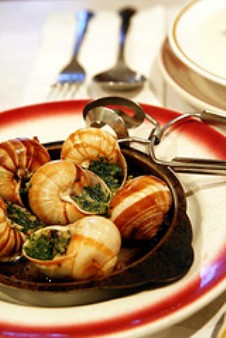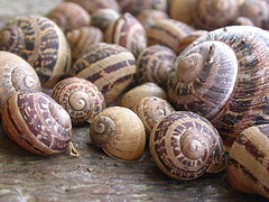Snails are a forkful too far for some people, but snails have a long and illustrious gastronomic history. On digs at prehistoric sites, archeologists have found great piles of empty snail shells. The Romans were very fond of them too and created snaileries where they were fattened up on a diet of wine and bran. In the Middle Ages they were served fried with onions or roasted over the fire on skewers. Sailors took them alive on board their ships for a meaty morsel while out at sea.

But it is the French who are the renowned eaters of these shelled gastropods. There, they mainly consume the Burgundy Snail or the Petit Gris, which incidentally is cultivated here in the USA. In the South of France they often cook them in wine with some salty bacon, a splash of olive oil, a few spices and of course a healthy helping of garlic. France is also the home to the classic entrée of snails stuffed with sizzling garlic butter, served in their shells in a special grooved dish called an escargotiere with a pair of tongs and a two pronged fork. The Portuguese are partial to a snail stew where they get through four tones a year. While the Greeks like to boil theirs in vinegar and also concoct a snail casserole with potatoes, tomatoes and squash. The Vietnamese use theirs to construct snail cakes, rather along the lines of what we would think of as a Thai fish cake. Even the British are getting in on the act, who hasn’t heard of Heston Blumenthall’s famous Snail Porridge.

In these thrifty times, it is possible to go gathering snails rather as they do in Provence, France. There they collect their snails and starve them for up to a week with just water and a smattering of thyme to impart flavor to the flesh. They are then steeped in salt and vinegar for a few hours, washed to remove the mucus, blanched for five minutes, followed by shelling to remove the black part at the end of the tail. Voila, there is your meaty and chewy delight.
But for those with deeper pockets, how about snail caviar? Available canned by De Jaegar in France where each of their snails produces 100 eggs per year of this cream pearl delicacy. De Jaegar describes their snail caviar as having “subtle autumn flavors with woody notes”. Best served at room temperature with a dash of sour cream this complex, time consuming product is reflected in its price of $129 for just 50g.
So this ingredient is certainly in keeping with the slow food movement’s mission which was set up to counteract fast food, they whiz along at speeds of up to 0.04 kilometers per hour - now that really is snail pace.
Photos courtesy of Flckr - Dave Appleton, Lumase, Aiyah and de Jaegar